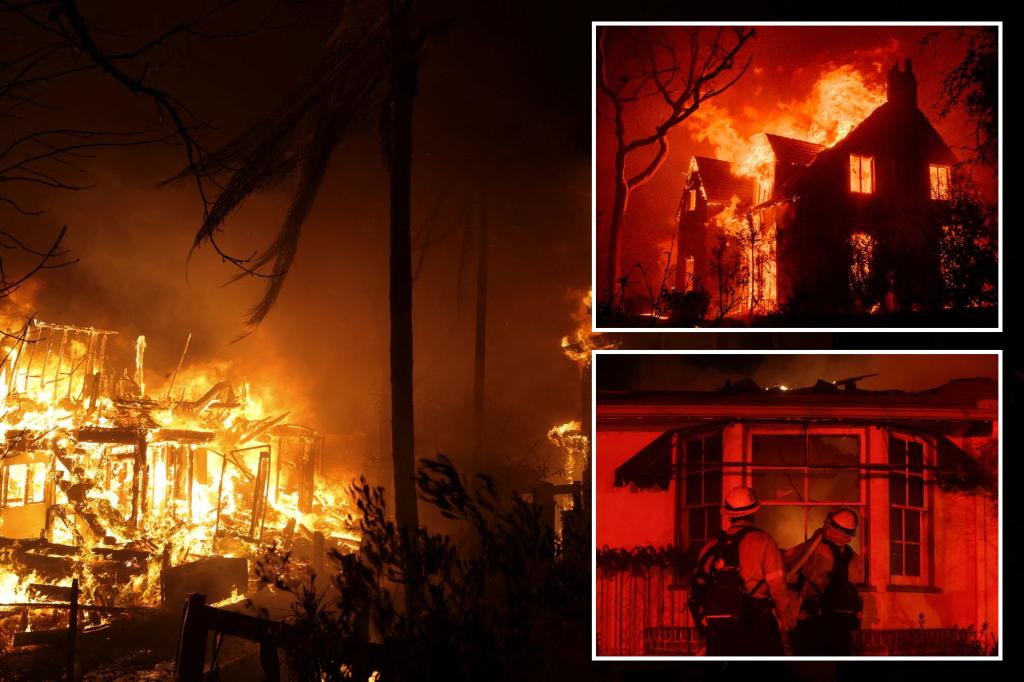The Eaton Fire, a rapidly spreading wildfire in Los Angeles County, has tragically claimed the lives of two civilians. The circumstances surrounding their deaths remain under investigation, with authorities yet to determine the exact cause. The blaze, which erupted with alarming speed, has consumed over 2,000 acres, equivalent to more than 3 square miles, leaving a trail of destruction in its wake. Containment efforts are yet to make any headway, with the fire remaining at 0% containment. The inferno has also resulted in significant injuries to an unspecified number of individuals, adding to the gravity of the situation. The scale and intensity of the fire pose a formidable challenge to firefighters battling the blaze.
The devastation wrought by the Eaton Fire extends beyond human casualties. Over 100 structures have been destroyed in the fire’s path, representing a significant loss of property and displacement for affected residents. The rapid expansion of the fire, fueled by dry conditions and possibly exacerbated by wind patterns, has overwhelmed initial containment efforts. The lack of containment underscores the urgency and difficulty of the ongoing firefighting operations. As firefighters grapple with the blaze, the focus remains on suppressing the fire’s spread and protecting lives and remaining structures.
The unfolding nature of the disaster makes it challenging to fully assess the extent of the damage and the full impact on the affected communities. As the fire continues to burn, the number of casualties and the extent of property damage may increase. The loss of two lives already serves as a stark reminder of the inherent dangers associated with wildfires, particularly in areas prone to dry conditions. The ongoing investigation into the cause of the fire will be crucial in understanding the factors that contributed to its ignition and rapid spread.
The response to the Eaton Fire involves a coordinated effort from various fire agencies, emergency responders, and support organizations. Firefighters are working tirelessly on the frontlines, employing various tactics to contain the blaze and protect surrounding areas. Their efforts include establishing fire lines, deploying water-dropping aircraft, and conducting ground-based firefighting operations. Simultaneously, emergency services are providing medical assistance to the injured and coordinating evacuation efforts for residents in threatened areas. Support organizations are also mobilizing to provide assistance and resources to those affected by the fire.
The Eaton Fire highlights the critical importance of wildfire preparedness and community resilience. In regions susceptible to wildfires, proactive measures such as creating defensible space around homes, developing evacuation plans, and staying informed about fire conditions are essential for mitigating risks and protecting lives and property. Public awareness campaigns play a vital role in educating communities about fire safety and promoting responsible behavior to prevent accidental ignitions. The ongoing incident also emphasizes the need for continued investment in firefighting resources and infrastructure to enhance the capacity to respond effectively to such emergencies.
As the situation continues to evolve, accurate and timely information dissemination is crucial for public safety and informed decision-making. Authorities are providing regular updates on the fire’s progress, containment efforts, and evacuation orders. Local media outlets and official channels are disseminating information to keep residents informed about the latest developments and any potential risks. Community support and collaboration are essential during this challenging time, as affected residents navigate the aftermath of the fire and begin the process of recovery. The Eaton Fire serves as a stark reminder of the devastating power of wildfires and the importance of collective preparedness and response.

